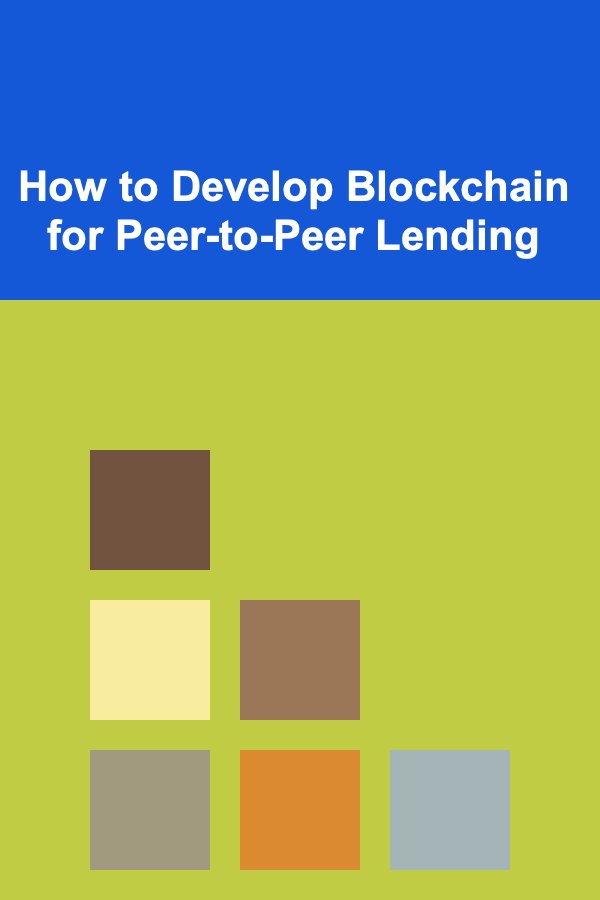
How to Develop Blockchain for Peer-to-Peer Lending
ebook include PDF & Audio bundle (Micro Guide)
$12.99$8.99
Limited Time Offer! Order within the next:

The peer-to-peer (P2P) lending industry has witnessed exponential growth in recent years, offering individuals an alternative to traditional financial institutions. By connecting borrowers directly with lenders, P2P platforms reduce the need for intermediaries, offering competitive rates and potentially lower fees for borrowers and higher returns for lenders. However, as the industry evolves, it faces numerous challenges, including fraud, lack of transparency, slow transactions, and security concerns.
Blockchain technology offers promising solutions to many of these challenges, providing a decentralized and transparent platform to facilitate peer-to-peer lending. This article delves into the process of developing a blockchain for P2P lending, exploring the fundamentals of blockchain technology, its potential impact on the industry, and the steps involved in creating a secure, efficient, and transparent blockchain-based lending platform.
Understanding Blockchain in the Context of P2P Lending
What is Blockchain?
Blockchain is a decentralized, distributed ledger technology that enables the secure and transparent recording of transactions across multiple computers in a network. Each transaction is stored in a "block," which is linked to the previous block, forming a chain. This structure ensures data integrity and prevents tampering, as altering one block would require changing all subsequent blocks, which is computationally infeasible.
In the context of P2P lending, blockchain can provide a transparent and immutable record of loan transactions, eliminating the need for intermediaries such as banks or lending institutions. It also enables smart contracts---self-executing contracts with the terms of the agreement directly written into code---allowing for automated, secure, and efficient loan processing.
Benefits of Blockchain in P2P Lending
- Transparency and Trust: Blockchain's decentralized nature allows all participants to view the same transaction history. This transparency helps to build trust between borrowers and lenders, as both parties can independently verify the terms of the loan and ensure that no fraudulent activities are occurring.
- Security: Blockchain's cryptographic security features ensure that transaction data is secure and resistant to tampering. Additionally, private keys, which are used to access blockchain accounts, provide an added layer of protection.
- Cost Reduction: By eliminating intermediaries such as banks, blockchain reduces transaction costs. This can lead to lower interest rates for borrowers and higher returns for lenders.
- Faster Transactions: Traditional lending systems often involve lengthy processing times, especially for international transactions. Blockchain technology can streamline these processes by providing near-instantaneous settlement of transactions.
- Access to a Global Market: With blockchain, P2P lending platforms can operate globally, allowing borrowers and lenders from different parts of the world to interact without the need for traditional financial institutions.
How Blockchain Enhances P2P Lending
Blockchain can address several challenges faced by traditional P2P lending platforms, including:
- Lack of Trust: Traditional lending platforms often require significant verification processes, which can slow down the lending process and reduce borrower-lender trust. Blockchain's transparent nature can overcome this issue by providing an immutable and verifiable history of transactions.
- Fraud and Security Risks: Fraudulent activities, such as identity theft and loan defaults, are common in traditional lending systems. Blockchain's cryptographic algorithms help to secure sensitive data, and the use of smart contracts ensures that loans are only disbursed when specific conditions are met.
- Slow Transaction Times: P2P lending on traditional platforms can take several days to process, especially when cross-border transactions are involved. Blockchain allows for real-time settlement, making it possible to process loans and payments much faster.
Key Components for Building a Blockchain-Based P2P Lending Platform
To develop a blockchain for P2P lending, several key components need to be considered, including the blockchain protocol, smart contracts, user interface, and integration with external systems. Below are the primary elements that constitute a successful blockchain-based P2P lending platform.
1. Blockchain Protocol
The first step in building a blockchain-based P2P lending platform is selecting an appropriate blockchain protocol. The choice of protocol depends on factors such as scalability, transaction speed, consensus mechanism, and security requirements. There are several blockchain platforms that could be used to build a P2P lending platform:
- Ethereum: Ethereum is a popular platform for building decentralized applications (dApps) and smart contracts. It offers high flexibility and supports a wide range of use cases, making it an excellent choice for blockchain-based lending platforms. Ethereum also has a well-established developer community and extensive resources for building decentralized applications.
- Hyperledger Fabric: Hyperledger is an open-source project that offers a permissioned blockchain platform. Hyperledger Fabric is particularly useful for building enterprise-grade blockchain applications, making it a good choice for a P2P lending platform that requires high levels of privacy and control over participants.
- Stellar: Stellar is a blockchain designed for fast and low-cost financial transactions. It offers high scalability and is specifically tailored for cross-border payments, which makes it an attractive option for P2P lending platforms with a global user base.
- Polkadot: Polkadot is a multi-chain platform that enables the interoperability of different blockchains. It allows for greater flexibility and scalability by connecting various blockchains together, making it a promising option for a decentralized P2P lending network.
The choice of protocol will affect the platform's scalability, transaction fees, and ability to integrate with other systems, so careful consideration must be given to this decision.
2. Smart Contracts
Smart contracts are essential to the functionality of a blockchain-based P2P lending platform. These self-executing contracts automatically enforce the terms of the loan agreement, eliminating the need for manual intervention. Smart contracts ensure that both borrowers and lenders adhere to the agreed terms, reducing the risk of disputes.
In a P2P lending scenario, smart contracts can automate several key processes:
- Loan Agreement: A smart contract can create the loan agreement once a borrower and lender agree on terms, such as the loan amount, interest rate, and repayment schedule.
- Fund Transfer: Once the smart contract conditions are met, the loan amount is transferred automatically from the lender to the borrower's wallet.
- Repayment Schedule: The smart contract can also handle loan repayments by deducting the agreed-upon amount from the borrower's wallet and transferring it to the lender.
- Collateral Management: If the loan is secured with collateral, the smart contract can enforce the release or liquidation of collateral in case of non-payment.
Smart contracts are written in programming languages like Solidity (for Ethereum) or Chaincode (for Hyperledger). It is crucial to thoroughly test and audit the smart contracts to ensure they are secure and function as intended.
3. Decentralized Identity Verification
In a traditional P2P lending platform, user identity verification is often handled by centralized authorities, such as banks or credit bureaus. In a blockchain-based platform, identity verification can be handled through decentralized identity solutions. These systems use blockchain to securely store and manage identity information, allowing borrowers to verify their identity without relying on a third-party intermediary.
One potential solution is Self-Sovereign Identity (SSI), where users control their identity and share it with others only when needed. Blockchain enables users to maintain a single, immutable identity across multiple platforms, ensuring that their identity cannot be altered or forged.
4. Tokenization of Loans
Blockchain can also enable the tokenization of loans, which allows for the fractional ownership of loans. By tokenizing loans, lenders can sell or trade their portions of a loan on secondary markets, providing liquidity and potentially diversifying their portfolios.
Tokenized loans can also be bundled together into blockchain-based securities, offering new investment opportunities for both individual and institutional investors. Tokenization improves the liquidity and efficiency of the P2P lending market, making it more attractive to a broader range of participants.
5. Security Measures
Security is paramount in any financial application, and blockchain-based P2P lending platforms must implement robust security measures to protect users' data and funds. Key security practices include:
- Cryptographic Algorithms: Blockchain uses advanced cryptography to secure transaction data. Private keys must be securely stored and protected, as they are essential for accessing users' wallets.
- Multi-Signature Authentication: Multi-signature authentication can be used to require multiple parties to approve transactions, adding an extra layer of security.
- Smart Contract Audits: Before deploying smart contracts, they should undergo rigorous audits to ensure they are free from vulnerabilities. External auditors and automated testing tools can help identify potential security flaws.
6. User Interface and Experience
A user-friendly interface is essential for attracting and retaining users on a P2P lending platform. The platform should be intuitive, easy to navigate, and provide real-time updates on loan statuses and repayments. Additionally, users should be able to easily manage their wallets and access transaction history.
Mobile app development is also a crucial consideration, as many users will prefer accessing the platform through their smartphones. Ensuring that the platform works seamlessly across devices will enhance the user experience.
Conclusion
Developing a blockchain for P2P lending offers numerous advantages, including increased transparency, security, and efficiency. By leveraging the power of blockchain, developers can create a decentralized lending platform that removes intermediaries, reduces costs, and fosters trust between borrowers and lenders. Key components such as blockchain protocols, smart contracts, decentralized identity verification, and tokenization are essential to building a secure and scalable platform. However, the success of such a platform also depends on ensuring the security of user data, conducting regular audits of smart contracts, and delivering a seamless user experience.
With the right approach, blockchain technology has the potential to revolutionize the P2P lending industry and provide a more efficient, secure, and transparent alternative to traditional lending systems.
Reading More From Our Other Websites
- [Small Business 101] Best Mobile POS Systems for Pop‑Up Markets and Farmers' Markets Vendors
- [Home Budget Decorating 101] How to Give Your Home a Fresh Look Without Buying New Furniture
- [Weaving Tip 101] From Loom to Luxury: How to Create Your First Hand-Woven Scarf
- [Organization Tip 101] How to Use Shoe Bags for Compact Storage Solutions
- [Organization Tip 101] How to Organize Your Sewing or Crafting Area
- [Ziplining Tip 101] Hidden Trails and Aerial Thrills: Exploring the World's Best Jungle Zipline Adventures
- [Home Soundproofing 101] How to Select the Right Soundproofing Materials for Walls, Floors, and Ceilings
- [Digital Decluttering Tip 101] The Ultimate Guide to Integrating Apps for a Seamless Digital Workflow
- [Polymer Clay Modeling Tip 101] Curing Secrets: Perfecting the Finish on Your Polymer Clay Jewelry Creations
- [Home Rental Property 101] How to Offer Pet-Friendly Rental Properties Without Risk

How to Properly Store Your Seasonal Items to Maximize Space
Read More
Talent Pipeline Mastery: Building, Selecting, and Cultivating Your Team
Read More
How to Understand the Role of Fats in Baking
Read More
How to Stay Connected with Your Team While Remote: A Comprehensive Guide
Read More
How to Bake Gluten-Free Delights: A Comprehensive Guide
Read More
How to Understand the Difference Between Good and Bad Carbs
Read MoreOther Products

How to Properly Store Your Seasonal Items to Maximize Space
Read More
Talent Pipeline Mastery: Building, Selecting, and Cultivating Your Team
Read More
How to Understand the Role of Fats in Baking
Read More
How to Stay Connected with Your Team While Remote: A Comprehensive Guide
Read More
How to Bake Gluten-Free Delights: A Comprehensive Guide
Read More